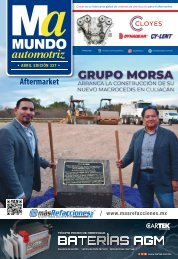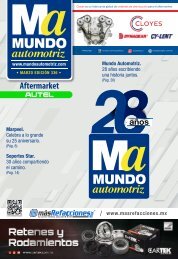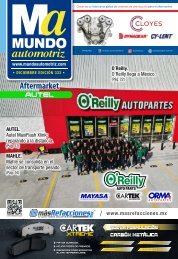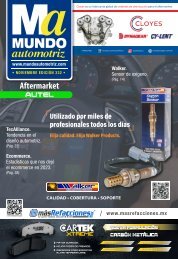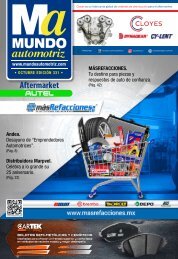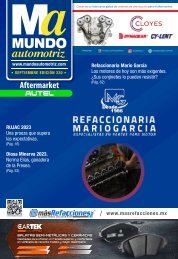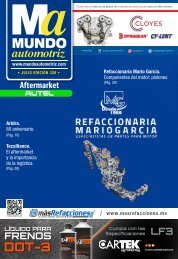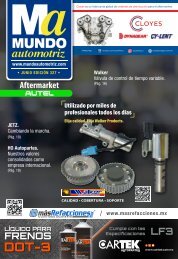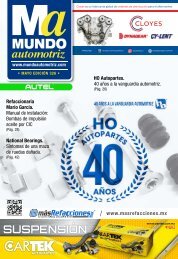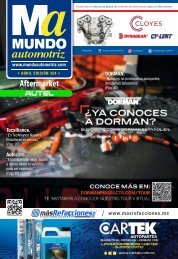Mundo Automotriz La Revista No. 241 Abril 2016
Los especialistas en Aftermarket
Los especialistas en Aftermarket
- No tags were found...
You also want an ePaper? Increase the reach of your titles
YUMPU automatically turns print PDFs into web optimized ePapers that Google loves.
ARTÍCULO TÉCNICO<br />
PARTICULATE FILTER<br />
This component also known as DPF (Diesel Particulate<br />
Filter) is a device connected to the exhaust pipe and is<br />
designed to remove soot particles from the exhaust of a<br />
diesel engine.<br />
This is a recent device, its use became mandatory since<br />
January 2010 to comply with Euro V anti-pollution standards,<br />
although many manufacturers were already using it nearly<br />
since 2000.<br />
FILTRO DE PARTÍCULAS<br />
Este componente también conocido como DPF por sus<br />
siglas en inglés “Diesel Particulate Filter” es un dispositivo<br />
conectado al tubo de escape y está diseñado para eliminar<br />
las partículas de hollín de los gases de escape de un motor<br />
diésel.<br />
Se trata de un dispositivo reciente, su uso se hizo obligatorio<br />
a partir de enero de 2010 al cumplir con normas anticontaminación<br />
Euro V, aunque muchos fabricantes ya lo utilizan<br />
desde el 2000 aproximadamente.<br />
A diferencia del catalizador, este componente “atrapa” las<br />
partículas de hollín y luego lo elimina del sistema ya sea<br />
con métodos de regeneración automática sujetos a las condiciones<br />
de conducción (regeneración pasiva) o por medio<br />
de la regeneración forzada que utiliza una herramienta de<br />
diagnóstico que ayuda a este proceso (regeneración activa).<br />
Como cualquier filtro que retiene las impurezas, estos dispositivos<br />
deben limpiarse regularmente para que mantengan<br />
su función, aunque los trayectos urbanos frecuentes así<br />
como la velocidad crucero promedio producen que los<br />
filtros no alcancen la temperatura óptima para la regeneración<br />
de las partículas que quedan atrapadas en el filtro,<br />
haciendo que pierda su eficacia y aumentando el consumo<br />
de combustible, por lo que se enciende la luz indicadora de<br />
avería en el tablero, indicando que algo está mal en el filtro<br />
de partículas.<br />
Unlike the catalytic converter, this component “traps” the soot<br />
particles and then removes them from the system either by<br />
automatic regeneration methods subject to driving conditions<br />
(passive regeneration) or through forced regeneration using a<br />
diagnostic tool to assist this process (active regeneration).<br />
Like any filter which retains impurities, these devices should<br />
be cleaned regularly to maintain its function, although<br />
frequent urban commuting and the low average cruise speed<br />
make the filters not to reach the optimum temperature<br />
to regenerate the remaining particles trapped in the filter,<br />
causing it to lose its effectiveness and increasing fuel<br />
consumption, making the check engine indicator to light up<br />
on the dashboard, indicating that something is wrong with<br />
the particulate filter.<br />
The filters are replaced normally between 80,000 km and<br />
200,000 km (50.000 to 125.000 Miles), depending on driving<br />
habits or when it’s detected that the particle filter can no<br />
longer be regenerated because of some situation in the<br />
engine, or faulty sensors that will cause irreversible damage<br />
to the filter.<br />
Particulate filter recommendations:<br />
a) Schedule a regeneration after 20,000 km. (12,500 miles) of<br />
urban use.<br />
b) Do a regeneration as soon as the warning light on the<br />
dashboard lights up.<br />
c) Read the recommendations for your vehicle in the user’s<br />
manual to understand the correct procedures.<br />
Los filtros normalmente se sustituyen entre 80,000 Km. y<br />
200,000 Km. (50,000 – 125,000 Millas) dependiendo de los<br />
hábitos de manejo o cuando se detecta que el filtro de<br />
partículas ya no puede ser regenerado a causa de<br />
alguna situación en el motor o sensores dañados<br />
que ocasionarán un daño en el filtro de forma<br />
irreparable.<br />
Recomendaciones para<br />
filtro de partículas:<br />
a) Programe una regeneración después de<br />
20,000 Km. (12,500 Millas) de uso urbano.<br />
b) Realice una regeneración en cuanto encienda<br />
la luz de advertencia del sistema en el tablero.<br />
c) Lea las recomendaciones de su vehículo<br />
en el manual de usuario para entender<br />
los procedimientos correctos.<br />
www.mundoautomotriz.com<br />
63





